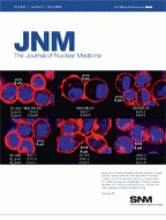TO THE EDITOR: Roy et al. recently published a study adopting a standardized protocol of intravenous insulin administration to reduce glycemia in diabetic cancer patients undergoing 18F-FDG PET (1). The authors claimed that the pretest intravenous insulin injection in diabetic patients is a realistic approach. However, several issues deserve further exploration before this standardized insulin protocol can be incorporated into daily PET practice.
In clinical tumor imaging, hyperglycemia has a recognized adverse effect on the quality of 18F-FDG PET images because of competitive inhibition of 18F-FDG uptake by glucose. Although insulin can be used as a glycemia-reducing agent, arbitrary prescription of insulin before 18F-FDG injection may exacerbate muscular 18F-FDG uptake and compromise tumor uptake, thus curtailing image interpretability (2). According to the study results of Roy et al., 18F-FDG PET image quality was barely adequate in 75% of patients receiving insulin. This means every 1 of 4 scans must be repeated. Repeating a study is not a cost-benefit if the PET center does not have its own on-site cyclotron. Rescheduling is inconvenient to the patients and bothersome to the center staff. The set point to prescribe insulin in the study protocol of Roy et al. might account for their poor image quality. The Society of Nuclear Medicine recommends rescheduling the examination if the patient's blood glucose level is greater than 8.3–11.1 mmol/L (150–200 mg/dL) (3). The European Association of Nuclear Medicine also advises that an 18F-FDG PET study should not be performed when the blood glucose level exceeds 11.1 mmol/L (4). If cancelling an examination or rescheduling an appointment is not feasible, we suggest the use of intravenous insulin at a blood glucose level of more than 11.1 mmol/L, instead of the 10.0 mmol/L stated by Roy et al. Additionally, we encourage hyperglycemic patients to have a temperate walk after insulin injection to reduce muscular uptake. In this way, the proportion of images of adequate quality would improve.
In their study, less favorable image quality was found with more glycemic reduction after insulin administration, and no significant correlation was observed between muscular uptake and parameters such as initial glycemia, total insulin dose, and number of insulin doses. Hence, the extent of glycemic reduction is not predictable and the chance of study failure is unavoidable. The implication is that we cannot select which hyperglycemic patient is suitable for insulin use. We also cannot apply the correct insulin dose to manage glycemic reduction before imaging. These phenomena can be explained by nonuniform insulin sensitivity among hyperglycemic patients. Therefore, Roy's standardized insulin protocol, an illogical practice such as sliding-scale insulin (5), is a problematic recipe for glycemic control in hyperglycemic patients undergoing 18F-FDG PET studies. Sliding-scale insulin is also associated with poorer glycemic control, a harmful roller-coaster effect between hyperglycemic and hypoglycemic episodes, and increased risks of hypoglycemia, as occurred in 6 patients (9.5%) in the study of Roy et al. Thus, their standardized insulin protocol might be a risky strategy.
To obtain a useful diagnostic image of 18F-FDG PET, one should ensure that the patient has fasted overnight and has a blood glucose level of less than 8.3 mmol/L in the early morning on the day of the PET scan. A good method is to do a “practice run” by checking the patient's blood glucose levels for at least 3 d before the 18F-FDG PET appointment (6). If the morning blood glucose level is persistently higher than 8.3 mmol/L, the scheduler needs to recognize this problem well before the scan appointment and request that the diabetologist manage the glycemic status by basal and nutritional insulin therapy with a supplemental insulin regimen (7). To avert the possibility of irreversibly unreadable images, hypoglycemia, and transcellular-shift hypokalemia, before establishing specific guidelines for using insulin in hyperglycemic patients undergoing 18F-FDG PET we should have the patients fast and we should not administer additional insulin.
Footnotes
-
COPYRIGHT © 2010 by the Society of Nuclear Medicine, Inc.







